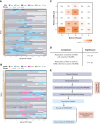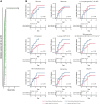Host metabolome predicts the severity and onset of acute toxicities induced by CAR T-cell therapy
- PMID: 36399526
- PMCID: PMC10468366
- DOI: 10.1182/bloodadvances.2022007456
Host metabolome predicts the severity and onset of acute toxicities induced by CAR T-cell therapy
Abstract
Anti-CD19 chimeric antigen receptor (CAR) T-cell therapy is a highly effective treatment option for patients with relapsed/refractory large B-cell lymphoma. However, widespread use is deterred by the development of clinically significant acute inflammatory toxicities, including cytokine release syndrome (CRS) and immune effector cell-associated neurotoxicity syndrome (ICANS), that induce significant morbidity and require close monitoring. Identification of host biochemical signatures that predict the severity and time-to-onset of CRS and ICANS may assist patient stratification to enable timely mitigation strategies. Here, we report pretreatment host metabolites that are associated with CRS and ICANS induced by axicabtagene ciloleucel or tisagenlecleucel therapy. Both untargeted metabolomics analysis and validation using targeted assays revealed a significant association between the abundance of specific pretreatment biochemical entities and an increased risk and/or onset of clinically significant CRS (q < .1) and ICANS (q < .25). Higher pretreatment levels of plasma glucose and lower levels of cholesterol and glutamate were associated with a faster onset of CRS. In contrast, low baseline levels of the amino acids proline and glycine and the secondary bile acid isoursodeoxycholate were significantly correlated with clinically significant CRS. Lower concentration of the amino acid hydroxyproline was associated with higher grade and faster onset of ICANS, whereas low glutamine was negatively correlated with faster development of ICANS. Overall, our data indicate that the pretreatment host metabolome has biomarker potential in determining the risk of clinically significant CRS and ICANS, and may be useful in risk stratification of patients before anti-CD19 CAR T-cell therapy.
© 2023 by The American Society of Hematology. Licensed under Creative Commons Attribution-NonCommercial-NoDerivatives 4.0 International (CC BY-NC-ND 4.0), permitting only noncommercial, nonderivative use with attribution. All other rights reserved.
Conflict of interest statement
Conflict-of-interest disclosure: N.G., B.T.H., D.M.R., A.J., C.E.H., and G.K. have intellectual property related to the detection of CAR T-cell–associated toxicities; D.M.R. has stock and other ownership interests in Interpares Biomedicine and Clariifi and intellectual property related to the detection of liver cancer; B.T.H. has received research funding from Takeda; consultancy, honoraria, research funding from Genentech, Karyopharm, Celgene, AbbVie, Pharmacyclics, BeiGene, AstraZeneca, Kite, a Gilead Company, and Bristol Myers Squibb; and consultancy and honoraria from Novartis, though not used for this study.
Figures





Similar articles
-
Novel prognostic scoring systems for severe CRS and ICANS after anti-CD19 CAR T cells in large B-cell lymphoma.J Hematol Oncol. 2024 Aug 6;17(1):61. doi: 10.1186/s13045-024-01579-w. J Hematol Oncol. 2024. PMID: 39107847 Free PMC article.
-
Optimizing the post-CAR T monitoring period in recipients of axicabtagene ciloleucel, tisagenlecleucel, and lisocabtagene maraleucel.Blood Adv. 2024 Oct 22;8(20):5346-5354. doi: 10.1182/bloodadvances.2023012549. Blood Adv. 2024. PMID: 39042880 Free PMC article.
-
Efficacy and Toxicity of CD19 Chimeric Antigen Receptor T Cell Therapy for Lymphoma in Solid Organ Transplant Recipients: A Systematic Review and Meta-Analysis.Transplant Cell Ther. 2024 Jan;30(1):73.e1-73.e12. doi: 10.1016/j.jtct.2023.05.018. Epub 2023 Jun 4. Transplant Cell Ther. 2024. PMID: 37279856
-
Clinical features of neurotoxicity after CD19 CAR T-cell therapy in mantle cell lymphoma.Blood Adv. 2024 Mar 26;8(6):1474-1486. doi: 10.1182/bloodadvances.2023011896. Blood Adv. 2024. PMID: 38295285 Free PMC article.
-
Safety evaluation of axicabtagene ciloleucel for relapsed or refractory large B-cell lymphoma.Expert Opin Drug Saf. 2023 Jan;22(1):5-15. doi: 10.1080/14740338.2023.2177268. Epub 2023 Feb 17. Expert Opin Drug Saf. 2023. PMID: 36737060 Free PMC article. Review.
Cited by
-
Riding the storm: managing cytokine-related toxicities in CAR-T cell therapy.Semin Immunopathol. 2024 Jul 16;46(3-4):5. doi: 10.1007/s00281-024-01013-w. Semin Immunopathol. 2024. PMID: 39012374 Free PMC article. Review.
-
Systemic toxicity of CAR-T therapy and potential monitoring indicators for toxicity prevention.Front Immunol. 2024 Aug 26;15:1422591. doi: 10.3389/fimmu.2024.1422591. eCollection 2024. Front Immunol. 2024. PMID: 39253080 Free PMC article. Review.
-
Bendamustine lymphodepletion before axicabtagene ciloleucel is safe and associates with reduced inflammatory cytokines.Blood Adv. 2024 Feb 13;8(3):653-666. doi: 10.1182/bloodadvances.2023011492. Blood Adv. 2024. PMID: 38113468 Free PMC article.
References
-
- Locke FL, Miklos DB, Jacobson CA, et al. Axicabtagene ciloleucel as second-line therapy for large B-cell lymphoma. N Engl J Med. 2022;386(7):640–654. - PubMed
-
- Sadelain M. CD19 CAR T cells. Cell. 2017;171(7):1471. - PubMed
-
- Schuster SJ, Bishop MR, Tam CS, et al. Tisagenlecleucel in adult relapsed or refractory diffuse large B-cell lymphoma. N Engl J Med. 2019;380(1):45–56. - PubMed

